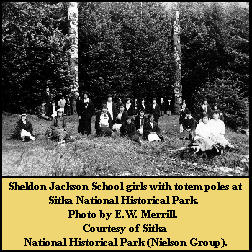 Sitka National Historical Park is the oldest federally designated park in Alaska. It was established in 1910 to commemorate the 1804 Battle of Sitka that took place between the Russians and the local Tlingit Kiks.ádi clan, and encompasses approximately 100 acres of forest, river, shoreline, and the restored 1840s Russian Bishop's House building.. The Park also contains a collection of totem poles which Alaska's District Governor John G. Brady brought to Sitka in 1905. The poles were gathered from other Southeast Alaska villages for the Louisiana Purchase Exposition of 1904 in St. Louis. The Park's Visitor Center has exhibits and houses the Southeast Alaska Indian Cultural Center, where visitors can watch and speak with Native artists at work.
Sitka National Historical Park is the oldest federally designated park in Alaska. It was established in 1910 to commemorate the 1804 Battle of Sitka that took place between the Russians and the local Tlingit Kiks.ádi clan, and encompasses approximately 100 acres of forest, river, shoreline, and the restored 1840s Russian Bishop's House building.. The Park also contains a collection of totem poles which Alaska's District Governor John G. Brady brought to Sitka in 1905. The poles were gathered from other Southeast Alaska villages for the Louisiana Purchase Exposition of 1904 in St. Louis. The Park's Visitor Center has exhibits and houses the Southeast Alaska Indian Cultural Center, where visitors can watch and speak with Native artists at work.
The Park has been and still is used for a variety of purposes. The local Kiks.ádi have a tradition of hunting, fishing, and plant gathering in the area which they continue. They also have held memorial potlatches at the Fort Site in honor of their ancestors who died in battle. Local Sitkans and visitors walk the wooded trails, view the totem poles, and enjoy the Park's natural beauty and peacefulness. Sitkans also used to gather there for picnics, and called one section "Lover's Lane."
Go to George Hall's interview to hear him talk about Park administration in the 1950s and 1960s, collection of Tlingit artifacts and recordings, and building the Visitor's Center in 1965.
Go to Ellen Hope Hays' interview to hear her talk about being the first female and first Native park superintendent, relations between the Park and local Tlingit, and establishment of the Southeast Alaska Indian Cultural Center.
Go to Early Views: Historical Vignettes of Sitka National Historical Park by Kristen Griffin (2000) to read more about the park's history.

